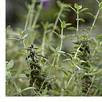With the future threatened by global warming looming in the air, there is no time better than the present for growing thyme. Gardeners replenish valuable nutrients back into the earth to help save the planet. Gardening has been, 'going green' long before it was cool!
Thyme, Thymus vulgaris, is a hardy aromatic herb of the Mint Family. These herbs have been cultivated since time began. (Pardon the pun.) The plants bloom small fragrant flowers to add a decorative border to gardens. Thyme has tiny sweet leaves bursting with a combination of lemon and mint flavors that are used for seasoning.
Growing thyme
Sow the seed indoors in a sunny location in early spring. Growing thyme is as easy as child's play. In fact, you could include your children in gardening activities. This will start another generation on the right path to protecting our environment. After the root-ball is established, it is time to take it outside, for the real fun to begin!
This herb grown outdoors prefers full sunlight. Thyme is not too picky about soil requirements (I told you it was going to be easy!) and a light, sandy well-draining bed will do fine. Growing thyme in dry, lean soil produces more fragrance and flavor in the herb.
It is not healthy for you or the plants to use harmful garden chemicals. Plants have an immune system that naturally resists pests and diseases. Make your own natural compost from kitchen waste or buy organic mixtures.
You can use cornmeal as an insecticide. Mulch with straw to take care of the weed population. Grass clippings and trimmings from trees and bushes can be recycled for mulching.
Thyme requires minimal plant food. Overfeeding is a danger when growing thyme. When fertilizers are washed away, it ends up polluting our important water system. Fertilizer runoff contaminates drinking water, and kills marine life.
Using low phosphate, earth-friendly fertilization when growing thyme, feeds the plants without harming the balance of nature.
Water on a regular schedule when growing thyme and avoid saturating the ground. The number one plant killer is over watering. By conserving water, you save gallons of water, time, and energy. Thyme is a 'drink responsibly' type of plant. Take advantage of its requirement for less water, and put down that hose!
Growing thyme invites birds, bees, and butterflies to your garden. These wildlife visitors are nature's pest control.
For maximum yield throughout the season, do not let the growing thyme flower. Thyme harvest is mid-summer, just before flowering. Simply snip a few stems for harvesting. Allow a few months growth, when growing thyme from seed, before cutting. Thyme can be harvested well into the winter.
Thyme's minty flavor is tasty in soups, stews, and meats. Sautéed and baked vegetables have a naturally sweet taste when flavored with thyme. Bake fish with sprigs of thyme for a mouth-watering meal.
Use recycled landscape materials instead of purchasing new, when making plans for growing thyme in the garden. Gardening is a worthwhile project for the entire family. It provides us with fresh air, exercise, healthy food, and more 'green' in our wallets!
"There can be no other occupation like gardening in which, if you were to creep up behind someone at their work, you would find them smiling." ~ Mirabel Osler
Michael Floren has been Growing Thyme for more than a decade and he is a gardening enthusiast. You can learn more about growing thyme and other great herbs at http://grow-herbs.net/
Article Source: http://EzineArticles.com/?expert=Michael_Floren
Hi my Name is Darren
I Started Growing my Own Food a few Years ago and i Love it.
When I Started it took Age's to find the Best information on How To Grow my Own Food.
So I have Put Together Some of The Best info I Found to Help others Like me to Grow there own.
Hope you Like it and i Hope it Help's
more will be added as i Find The Best info
Thank's Darren
When I Started it took Age's to find the Best information on How To Grow my Own Food.
So I have Put Together Some of The Best info I Found to Help others Like me to Grow there own.
Hope you Like it and i Hope it Help's
more will be added as i Find The Best info
Thank's Darren
